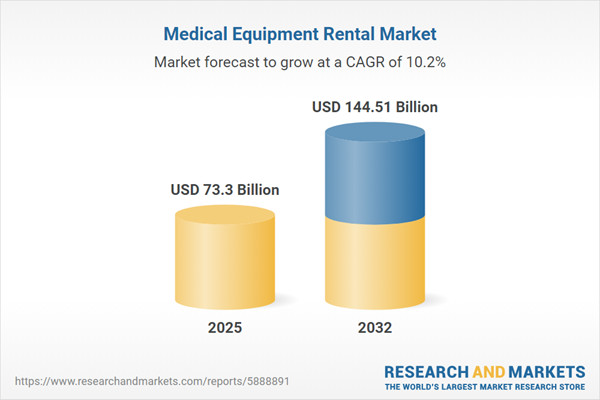Speak directly to the analyst to clarify any post sales queries you may have.
The medical equipment rental market offers healthcare executives a strategic approach to acquiring advanced technologies, helping organizations manage financial balance, operational complexity, and ongoing technological advancement.
Market Snapshot: Medical Equipment Rental Market Insights
The global medical equipment rental market is witnessing sustained double-digit compound annual growth, driven by rapid adoption among hospitals and care providers. This expansion is supported by value-based care models and a significant shift toward digital transformation. Leading healthcare organizations use rental models to facilitate technology upgrades aligned with evolving clinical priorities, efficiently respond to regulatory changes, and avoid capital-intensive purchases. Rental solutions simplify deployment, providing consistent support for uninterrupted care delivery and reliable operational uptime in various clinical settings. As compliance and technology needs become more dynamic, flexible rental strategies allow healthcare leaders to navigate shifting requirements effectively.
Scope & Segmentation of the Medical Equipment Rental Market
- Equipment Types: Diagnostic imaging devices—including CT, MRI, ultrasound, and X-ray systems—improve clinical precision. Cardiac, fetal, and vital sign monitoring support detailed patient assessment. Surgical equipment, such as endoscopy, laser, and robotic platforms, enable complex interventions. Therapeutic devices for infusion, dialysis, and respiratory functions broaden acute and chronic care options.
- End-Users: Hospitals, clinics, ambulatory surgical centers, diagnostic units, and home care settings benefit from equipment rental programs, providing versatile support across acute and post-acute care environments.
- Rental Duration: Long-term rentals assist with stable resource planning and continuous service, while short-term options promote rapid scaling for surges, technology pilots, or project-based needs.
- Rental Modes: On-premise rentals maintain immediate device availability at the point of care, enhancing workflow continuity. Off-premise models, coordinated through third-party logistics, efficiently serve geographically dispersed or multi-site operations.
- Clinical Applications: Rental solutions support specialty teams in cardiology, neurology, oncology, and orthopedics, enabling advanced care pathways and expanding clinical capabilities, especially in underserved regions.
- Geographical Regions: The Americas lead, supported by robust technological investment. Regional practices in Europe, the Middle East, and Africa are shaped by procurement strategies and regulatory factors. Modernization across Asia-Pacific, especially in China and Southeast Asia, is accelerating adoption in new markets.
- Leading Companies Covered: Market leaders such as Linde PLC, Amedisys, Baxter International, Invacare, Arjo AB, Rotech Healthcare, Drive DeVilbiss Healthcare, National Seating & Mobility, Kinetic Concepts, and Patterson Companies provide comprehensive portfolios and flexible rental programs to address diverse operational demands.
Key Takeaways for Senior Decision-Makers
- Digital monitoring and predictive analytics are transforming asset tracking, enabling precise oversight and strategic deployment of critical healthcare devices in complex settings.
- Subscription-oriented rental models empower organizations to flexibly adapt technology infrastructure as clinical needs or patient volumes fluctuate, supporting effective budgeting and dependable device access.
- Strategic alliances between healthcare providers and rental partners enhance access to cutting-edge equipment, streamline clinical operations, and maintain high standards of patient care delivery.
- Procurement variations by region, such as modular rental systems or data-driven contracts, help organizations align equipment strategies with changing operational and regulatory standards.
- Strengthened supply chain and inventory management practices are pivotal for reducing operational risk and ensuring continuity, particularly during transitions in technology or periods of fluctuating demand.
Tariff Impact: Navigating Trade and Sourcing Shifts
Recent changes to medical device tariffs are prompting healthcare decision-makers to adapt procurement and sourcing strategies. Enhancing collaboration with local suppliers and prioritizing in-country procurement can support cost management and minimize risk of disruption. Regular reviews of service agreements and investment in resilient supply chain practices are vital to sustaining device availability and compliance amid global trade fluctuations.
Methodology & Data Sources
This report relies on direct executive interviews, clinician insights, recent equipment utilization data, and established literature. An expert panel of medical equipment specialists thoroughly validated all findings to ensure practical relevance for senior healthcare stakeholders.
Why This Report Matters to Senior Stakeholders
- Delivers actionable segmentation and insight to guide strategic procurement, operational agility, and financial planning for leadership teams.
- Prepares organizations to respond to regulatory changes and optimize delivery models for cost-effectiveness and operational resiliency.
- Explores technology innovations and regional market variations with direct relevance to decisions in the medical equipment rental sector.
Conclusion
The medical equipment rental market equips executive teams with scalable solutions, supporting innovation, operational flexibility, and focused cost management. Rental frameworks enable healthcare organizations to stay responsive and resilient as clinical needs and technologies evolve.
Additional Product Information:
- Purchase of this report includes 1 year online access with quarterly updates.
- This report can be updated on request. Please contact our Customer Experience team using the Ask a Question widget on our website.
Table of Contents
3. Executive Summary
4. Market Overview
7. Cumulative Impact of Artificial Intelligence 2025
Companies Mentioned
The companies profiled in this Medical Equipment Rental market report include:- Linde PLC
- Amedisys, Inc.
- Baxter International Inc.
- Invacare Corporation
- Arjo AB
- Rotech Healthcare, Inc.
- Drive DeVilbiss Healthcare, LLC
- National Seating & Mobility, Inc.
- Kinetic Concepts, Inc.
- Patterson Companies, Inc.
Table Information
| Report Attribute | Details |
|---|---|
| No. of Pages | 196 |
| Published | October 2025 |
| Forecast Period | 2025 - 2032 |
| Estimated Market Value ( USD | $ 73.3 Billion |
| Forecasted Market Value ( USD | $ 144.51 Billion |
| Compound Annual Growth Rate | 10.2% |
| Regions Covered | Global |
| No. of Companies Mentioned | 11 |









